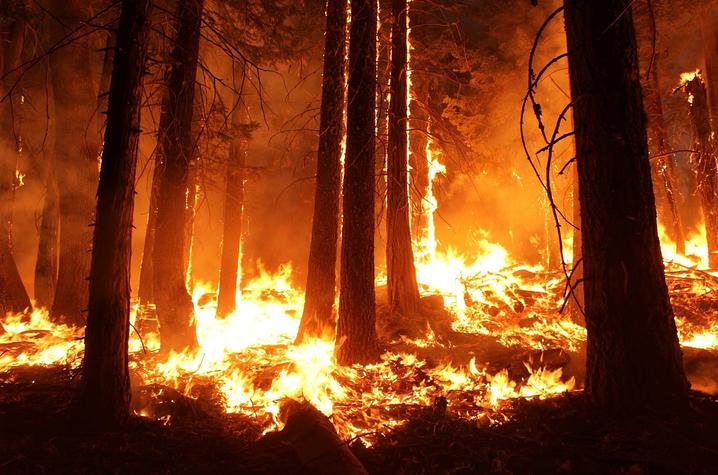Think Before Striking That Match; Fall Forest Fire Season is Here

LEXINGTON, Ky. (Oct. 23, 2019) — Kentucky’s fall forest fire season started Oct. 1 and runs through Dec. 15. Coming with a late summer, early fall drought, it behooves folks to be cautious and aware of how their activities could spark both a natural and economic disaster.
Revenues from timber harvests, primary industries such as logging and milling, and secondary manufacturing industries added $13.5 billion in direct, indirect and induced revenue to the state’s economy in 2018, said Jeff Stringer, chair and extension silviculture professor in the University of Kentucky Department of Forestry and Natural Resources. Loss of such valuable resources through fire can be devastating to an area.
“Our research shows a 57% to 71% loss of high value timber products in stands that are subjected to severe or repeated wildfires,” Stringer said. “Trees that contain veneer, lumber and barrel logs can easily be degraded. The loss in value to the landowner is significant and to our rural economies even more.”
Forests are not just the sum of their timber products, however. They provide cleaner air and water and capture carbon, keeping it from entering the atmosphere. Woodlands add to the biodiversity of the state and provide wildlife habitat, as well as recreational opportunities. Wildfires can have both short-term and long-term effects on these highly valuable forest assets.
While there are both spring and fall fire seasons, warm temperatures, low humidity, lack of rain and falling leaves make autumn a particularly fire-prone season. Weather alone is seldom to blame for igniting a wildfire. Lightning strikes account for a mere 1% of fires in the state, according to the U.S. Forest Service. Rather, it is humans who are responsible for setting the vast majority of forest fires, whether it is accidentally through uncontrolled campfires or burning debris or a deliberate act of arson.
“We all have a responsibility to keep our woodlands safe. During forest fire season, it is against the law to burn anything within 150 feet of any woodland or brushland between 6 a.m. and 6 p.m.,” said Laurie Taylor Thomas, extension forester in the UK College of Agriculture, Food and Environment. “Outdoor burning after 6 p.m. is allowed, because the higher humidity after sunset means a wildfire is less prone to spread.”
A ban on burning may be issued whenever there are drought conditions in a county that result in extraordinary fire danger. County burn bans are issued by the judge executive. Violation of a burn ban is a misdemeanor punishable by law. More than 40 Kentucky counties have issued burn bans this month. Generally, such bans prohibit:
- Burning of forest, grass, crops, woodlands, marshes or other similar areas.
- Burning debris or household trash.
- Campfires, bonfires and warming fires.
- Open pit cooking and charcoal grilling.
Fireworks and welding could also be prohibited or regulated.
In addition to following rules and regulations for debris burning, people living in or near forests should prepare their homes and properties to protect them from forest fire damage. There are many simple steps homeowners can take to reduce wildfire risk. The Kentucky Division of Forestry provides easy tips on their website.
“Building and seasonally maintaining fire breaks can help reduce the risk to your property, as does regularly raking up leaves and pine needles from around your foundation,” Thomas said. “Also, keeping an eye on your property and talking to neighbors about outdoor burning is prudent.”
The U.S. Department of Agriculture Forest Service provides information about fire restrictions and warnings on their website. Residents may also call their local fire department for alerts and warnings. The Kentucky Division of Forestry lists current county burn bans on their website.
As the state’s flagship, land-grant institution, the University of Kentucky exists to advance the Commonwealth. We do that by preparing the next generation of leaders — placing students at the heart of everything we do — and transforming the lives of Kentuckians through education, research and creative work, service and health care. We pride ourselves on being a catalyst for breakthroughs and a force for healing, a place where ingenuity unfolds. It's all made possible by our people — visionaries, disruptors and pioneers — who make up 200 academic programs, a $476.5 million research and development enterprise and a world-class medical center, all on one campus.




